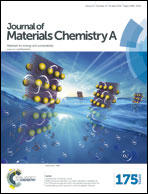Marked inducing effects of metal oxide supports on the hydrothermal stability of zeolitic imidazolate framework (ZIF) membranes†
Abstract
The thermal and hydrothermal stabilities and the structural degradation characteristics of a supported ZIF-7 membrane were studied at various temperatures (423–673 K), H2O vapor concentrations (10–40 mol%), and metal oxide supports (alumina, silica–alumina, silica, magnesia). The α-Al2O3 supported ZIF-7 membrane prepared by the seeding and secondary growth method exhibited a high H2 permeance (4.0 × 10−7 mol m−2 s−1 Pa−1) with high H2 selectivities (∼10) over larger CO, CH4, and CO2 gases at an elevated temperature of 573 K. The thermal stability of the membrane in a dry atmosphere was determined primarily by the intercrystalline grain boundaries on the ZIF-7 overlayer, exhibiting a high thermal stability at 573 K. However, considerable cracks developed through the grain boundaries at 673 K due to excessive thermal stress. It was found that the metal oxide supports markedly affect the hydrothermal stability of the ZIF membranes. The α-Al2O3 supported membrane suffered from fatal hydrothermal degradation of the ZIF-7 membrane layer even at a relatively low temperature of 473 K, and structural degradation was facilitated as the temperature and H2O vapor concentration increased. Surface acid/base properties of the metal oxide supports had a critical impact on the stability of the membrane; the ZIF-7 structure exhibited severe hydrothermal degradation on the acidic Al2O3 and SiO2–Al2O3 supports. Conversely, the ZIF-7 crystalline structure remained intact on the neutral SiO2 and basic MgO supports even under highly antagonistic hydrothermal conditions (573 K, 20 mol% H2O). These findings provide important new insights for the effective construction of ZIF membranes with improved structural stabilities under practically relevant thermal and hydrothermal operation conditions.


 Please wait while we load your content...
Please wait while we load your content...